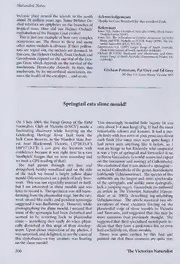
Springtail Eats Slime Mould! PDF
Preview Springtail Eats Slime Mould!
NaturalistNotes tectonic plate neared the islands to the north Acknowledgements about 20 million years ago. Some Helmet Or- ThankstoCamBeardsellforthiswonderfultale. chid relatives are epiphytes on the branches of tropical trees. How did our Helmet Orchids’ References exploitationoftheFungusGnatevolve? lonFer.es,ncDl.ils..FNoraetsitv,eNOSrcWh)idsofAustralia(1988).(ReedBooks: This isjust one example ofhowvery complex (ones,D.L.Thepolliiialioii ofCorybasdiemenicus(H.M.R.) ecosystems are. The threat to these and many RuppandW.tt.NicholisexH.M.R.Rupp(1970). The Vic- other native orchids is obtdous. Iftheirpollina- GrtgourriiannoNvaitcuraCiiAst.(18979(72)),L3a7r2g-e3r74.Fungi ofSouth Australia. tors are wiped out, the orchids are doomed. In (StateGovernmentof.SouthAustralia:Adelaide) thiscase,theHelmetOrchids,GnatOrchidsand Cleland JB (1976) Toadstools and Mushrooms and Other Greenhoodsdependonthesurvivalofthe Fun- ALdaerlgaeirdFeu)ngiofSouth Australia (GovernmentPrinter,SA: gus Gnat,which dependson the survival ofthe mmuusshhrroooomm,, bDyerimtsocmyycboerrchlielzaanldiia.ssIonciattuironn,,tehni-s GrahamPatterson,PatGreyandEdGrey suresthehealthoftheeucalypts...andsoon. POBox175,LowerPlenty,Victoria3093 Springtail eats slime mould! On 5 July 2009, the Fungi Group ofthe Field This stunningly beautiful little beastie (it was Naturalists Club of Victoria (FNCV) made a onlyabout3-4mmlong) (Fig. 1) hadthemost fascinating discovery while foraying on the remarkable colours and features. It had a pur- Lerderderg Heritage River Trail from the plebodywithtworowsofpinkprocessesdown Jack Gann Reserve, in the Wombat State For- each flank (the outer ones were quite long). I est, near Blackwood, Victoria. (37°28'35.4"S had never seen anything like it before, so I 144°17T3.2”E; I can give the location with sent an image to Ian Endersby who suspected confidence because it was right next to a rare it was a type ofspringtail and forwarded it on ‘toothpick’ fungus that we were recording and toPennyGreenslade(aworld-renownedexpert wetookaGPSreadingofthat). on the taxonomy and ecology ofCollembola). The trail passes through dry box and Sheconfirmedthatitwas indeedaspringtail— stringybark heathy woodland and on the side an uchidCollembolaofthegenusAcanthanura of the track we found a bright yellow slime (subfamilyUchidanurinae). Thespeciesofthis mould (Myxomycete) ona patch ofleafyliver- subfamily are the largest and most spectacular wort. This was notespecially unusual in itself, ofthe springtails, and unlike most springtails, but I am intere.sted in slime moulds and was lack ajumping organ. Greenslade co-authored keentorecordit. Thespecimenwasstilltrans- an article in The Victorian Naturalist (Green- formingfromtheplasmodialstage,butthevery slade et al. 2002), describing log-inhabiting weakstrand-like stalks and pendant sporangia Uchidanurinae. The article recorded two ob- suggesteditwasBadhamia sp. However, while servations of these creatures feeding on the photographing the slime mould, I noticed that plasmodial stage of slime moulds in Victoria some ofthe sporangia had been disturbed and and Tasmania, and suggested that this may be seemed to be reverting back to plasmodial more common than previously thought. She slime— something they easily do when physi- suggestedthat theirspecialised mouthparts in- cally disturbed at this stage of their develop- dicate that they have a preference for, or even ment. Upon closer inspection ofmy photos, I feedexclusivelyon,slimemoulds. wassurprised,anddelighted,toseethecauseof Penny was quite excited by this find and — this disturbance a tiny creature was feasting pointed out that these creatures are quite rare ontheslime mould! 206 TheVictorianNaturalist NaturalistNotes that colonise slime moulds. Myxomycetes typicallyfeed onbacteriafoundin decay- ing wood and litter; how- ever, there is evidence that some slime moulds prefer growing amongst mosses — and liverworts presum- ably these provide a suit- ablehabitatforsporulation. Someslimemoulds also are known to feed on fungal spores. Unfortunately, I did not collect the Collembola (it didn’t occur to me to do so at the time, and I wouldn’t have known how to handle itanyway). Ididcollectthe slimemouldbuttheanimal appearedtohavefledpretty Springtailonslimemould. quickly(althoughitseemed unperturbed bypeopletaking photographs for and endangered by fire and logging. Large about 15minutes). partsoftheareawevisitedwererecentlyburnt, Tobehonest,Iwasgladitdeparted,becauseI and the Wombat State Forest does have pro- didnotwantittoeatalltheslimemouldbefore posedloggingcoupes(although notinthearea I had a chance to examine it. As it happened, around the Heritage Walk where we were), so much ofthe slime mould disintegrated on the the threats mayhavebeen quitecloseforthese journeyhome. particular individuals. The weat—her was cold, I believe the slime mould was Badhamia sp., overcast and tending to drizzle ideal condi- but my microscopical examination was con- tions for uchid springtails (and many slime strainedbytheveryfewsporangiathathadma- moulds),whichlikelowtemperaturesandhigh tured. It had darkbrown,wartyspores, mean humidity. size 12.1 by 11.0 pm. with large limey plates The FNCV Fungi Group often finds spring- (capillitiawerenotobserved). tailsamongstthegillsoffungi. Pennyhasfound that some endemic species and even genera of References Collembolaspecialise on fungi, andsome feed Greenslade P, Moore S and Farrow R (2002) Observations exclusivelyonthefungalspores. onthefeedingbehaviourofUchidanaurinae(Collembola: Neanuridae) in Australia. The Victorian Naturalist 119, The ecology offungi, slime moulds and in- 221-223. sects is fascinating. Stephenson and Stempen GreensladeP(2002)Collembolaassociatedwithfungalfruit- (2000) describe beetles that are commonly StbeopdhieenssoinnASuLstarnadliSa.tePmedpoebnioHlo(g2i0a0046),M3y4x5o-m3y5c2e.tes:AHand- foundfeedingonthesporangiaorplasmodium bookontheSlimeMolds(TimberPress:Portland,Oregon) of slime moulds and suggests that some are obligate myxomycete specialists. Certain spe- PaulGeorge cies offlies are also known tolayeggs in slime 238CanterburyRoad mould plasmodium and the larvae feed on the Canterbury,Victoria3126 plasmodium. Therearealsoanumberoffungi Vol 127 (5) 2010 207
